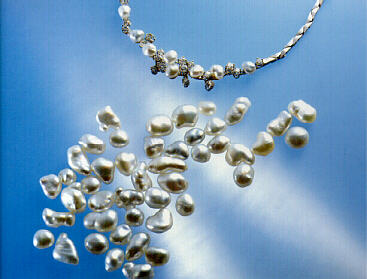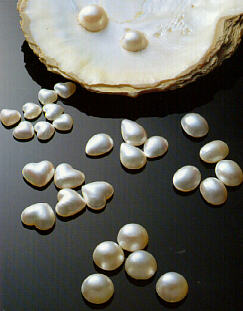
 |
![]()
There are several other kinds of pearls available you might wish to consider. Again, it is always best to rely upon the judgement of a jeweler whose expertise can save you time in making a proper selection, and help you obtain maximum value for your investment.
Keshi Pearls

Keshis are created naturally in the soft tissue of most cultured pearl-bearing oysters and mussels. They are usually formed by the accidental intrusion of tiny natural organisms such as parasites, eggs, sand, fragments of shell, or small particles of mantle tissue that have detached themselves from the implanted nucleus.
After the larger cultured pearls have been removed from the mother shell, the keshis are carefully collected. They are regarded by the cultured pearl farmer as a valuable by-product of his harvest. The smallest keshis are not much larger than a pinhead, hence the origin of their alternate
names: "seed" or "poppy" pearls.
Because of the painstaking effort the bigger keshis, from oysters bearing involved in drilling and stringing the very South Sea cultured pearls, may exceed small-sized variety of keshis, they are often 10mm. These rarer and very valuable pieces sent for processing to countries where labor are set into rings, pendants, earrings, brooches, costs are low. Also, due to being naturally and are even occasionally made into strands. produced (i.e., containing no man-made nuclei), keshi pearls are often ground up large or small, keshi pearls are and used for medicinal purposes in places appreciated by pearl fanciers worldwide such as India, Hong Kong and China.
The bigger keshis, from oysters bearing South Sea cultured pearls, may exceed 10mm. These rarer and very valuable pieces are set into ring, pendants, earrings, brooches, and are even occasionally made into strands.
Large or small, keshi pearls are appreciated by pearl fanciers worldwide and generally command high prices. and generally command high prices
Mabe Pearls
 The mabe pearl oyster is found mainly in the tropical seas of Southeast Asia and in the Japanese islands around Okinawa. Its scientific name is pteria penguin, meaning "penguin wings." The mabe oyster has a beautiful, rainbow-colored iridescence that ranges from light pink through dark rose to
slightly bluish shades, often with a metallic luster.
The mabe pearl oyster is found mainly in the tropical seas of Southeast Asia and in the Japanese islands around Okinawa. Its scientific name is pteria penguin, meaning "penguin wings." The mabe oyster has a beautiful, rainbow-colored iridescence that ranges from light pink through dark rose to
slightly bluish shades, often with a metallic luster.
From the early 1900s until today, many attempts have been made to cultivate round pearls from the mabe oyster, but all have commercially failed. However in the 1950's, hemispherical pearls were successfully cultivated. Today, most of these cultured hemispheric pearls (or "half pearls" as they are more commonly known) do not come from the mabe oyster, but rather from the South Sea's silver-lipped pictada maxima.
Several hemispherical, plastic nuclei are glued directly to the insides of the upper and lower shells of the mother oyster which then begins to secrete nacre over the intruders.
At harvest time the half pearl "caps" are stamped out and each nucleus is removed, leaving only a thin, hemispherical coating of hardened nacre which is sometimes only the thickness of a fingernail. This hollow cap is then filled with a resinous paste and closed on the bottom with mother-of-pearl.
Depending upon the form of the nucleus the farmer inserts into the mother oyster, other shapes of half pearls such as ovals, cushions, drops, three-quarters and hearts can result.
Cultivating half pearls often makes efficient use of oysters near the end of their life cycle and only a relatively short cultivation period is needed. It is also a much simpler process than cultivating spherical pearls. Thus, half pearls are rather inexpensive, even the larger ones ranging up to 22mm.